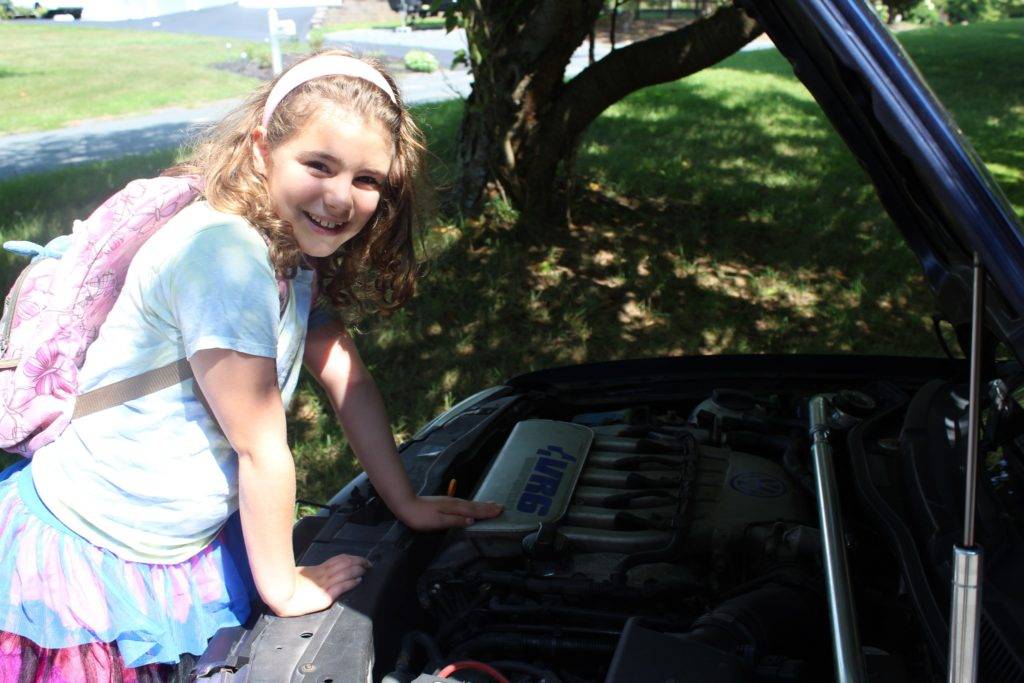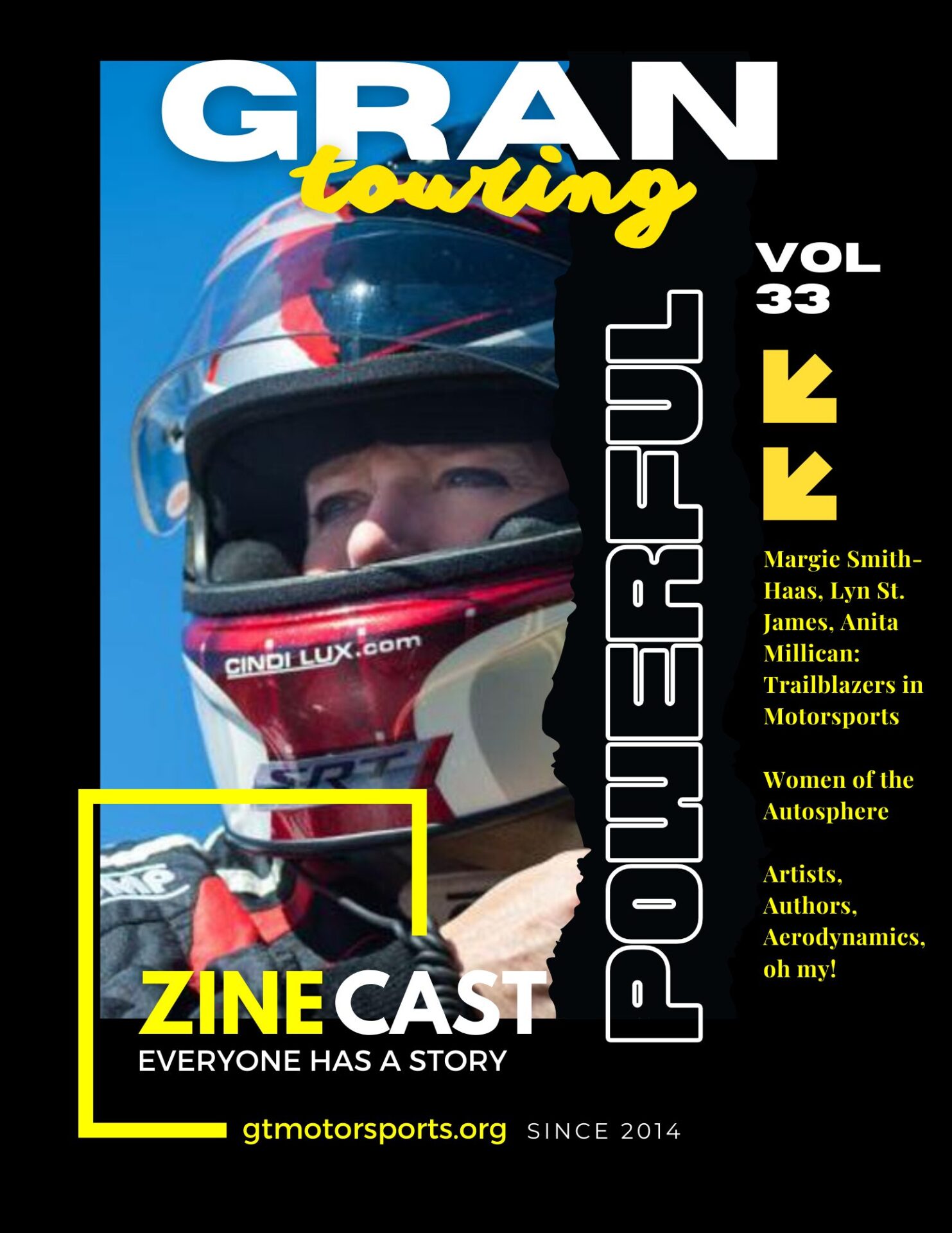Remember that show with Jeff Foxworthy where we used to watch people show off how smart they were and if they could pass a fifth-grade exam? Well… Tonight, we’re taking a Break/Fix spin on that, in “Can you explain it to a 3rd grader?” a back to school special where Mountain Man Dan squares off against automotive questions from our 8 year old panelist, Clio.
Tune in everywhere you stream, download or listen!
 |  |  |
- Notes
- Transcript
- Learn More
Notes
- Why do cars need motor oil?
- What part of the car makes it stop?
- What parts of the car breaks easily?
- How does the engine work?
- Can cars survive crashes or big big fires?
- How does electricity get used in a car?
- Do people race in old-fashioned cars?
- Are there self-driving cars?
and much, much more!
Transcript
[00:00:00] Hello and welcome to the Gran Touring Motor Sports Podcast Break Fix, where we’re always fixing the break into something motor sports related.
Remember that show with Jeff Foxworthy where we used to watch people show off how smart they were and if they could pass a fifth grade exam. Well, tonight we’re taking a break fix spin on that in a special called, can you Explain it to a third grader where Mountain Man Dan squares off against automotive questions from our eight year old panelist who just happens to be my daughter Cleo.
So I don’t know about y’all, but I can’t wait to see how this turns out. And with that, let the games begin. Okay, Mr. Dan, I’ve written down 11 questions about cars that I wanna know. And you’re gonna have to answer all, okay. Why do cars need motor oil? Can’t they just run off electricity? That wouldn’t have to deal with the fact that electricity would be an electric car [00:01:00] and the normal internal combustion engine or diesel engines are requiring.
Oil for lubrication because there’s components inside the engines that move, and without the lubrication, the metal will get hot and seize up. I do believe that even some of the electrical vehicles, some of the components on those might require oil for lubrication as well, but as I’m not very versed in electric vehicles, don’t hold me to that.
Okay. Are you ready for the second question? I am ready. What part of the car breaks very easily. That could be a long list of things. So I would say apart that breaks, I would say for breaking very easily from the early to mid eighties on when they started putting a lot of plastic components in vehicles, especially like interior pieces, they break very easily and especially with young children such as yourself, you guys not exactly the most gentle with interior components.
So it is not uncommon for something in the interior of the vehicle to break. But did you have some specific in regards to. Items that break. I was thinking [00:02:00] like something inside the car, like name one thing inside the car that could break like very easily if the car were to break down again. I would say a very common thing for cars to break down alongside the road would be something such as a belt for the engine.
You know, if a belt breaks on the car, then you can lose things like your alternator, which is what gives you power or your power steering, which makes it more difficult to turn or do you think will clear. What kind of belt are you talking about? Are you, like you talking about the seatbelt or like a different kind of belt?
A different kind of belt. The belt on the car engine, there’s multiple types. There’s VB band, there’s rib. Most newer cars go with a rib style, which is for a serpentine system. So basically if you take in, just make a complete. Loop, and that’s what your belt is. It’s from start to finish. It just continues and it’s made of like a rubber material.
Some have fiber in them, like thread type material inside of them to help make them stronger. And they’ve been used on cars [00:03:00] for hundreds of years now, since the beginning. I remember. It’s kinda like. The pattern is like up and over. It’s kind of like castle Walls, how they’re like this, but smaller and on a circle wheel or like a circle chain.
Yeah. Similar like when you’re out in the garage with your dad and you. See on the side of the engine, you’ll see the belt there. And of course, we’ve got plenty of times, we have the engines out of the cars there. And when you’re paying attention to what we’re doing and not just playing and writing with chalk in the driveway and stuff, we’ll be glad to point it out to you.
Okay. Are you ready for question three? I think I am. What part of the car makes it stop? I’m talking about like the brake on the car. What part of the brake makes the car stop? Okay, so originally one of the very original methods of brakes, and I believe it was with Mercedes, when they first built the first [00:04:00] vehicle, they used wood and leather material for the brake pads.
The original versions were used with. Like a drum type system uses pressure to push out and that friction calls it to slow down. And then there’s also styles where they use a brake around where it’s, it’s a wheel and it’ll have like a strap come around it. When pressure’s applied, it draws pressure on the outside of that.
But with motor vehicles, it’s more common to see the drum or newer vehicles from probably the late seventies, early eighties on, they have what’s called a rotor and a caliper setup. And what that does is, The rotor will spin and a caliper sits on it. When you push the brake pedal, it’ll squeeze in on the side of it so it’s moving freely and easily.
And then when you push the pedal, it’ll squeeze in on it and uses hydraulic pressure to push in on that. The friction causes you to slow it down, but then there’s also, other than hydraulic, one larger vehicles such as your tractor and trailers, they use air brakes. And air pressure is what actually holds the brakes disengaged.
When you push the pedal, the air is [00:05:00] released out of the valve to put pressure on, and there’s also electric brakes on trailers, which it uses electromagnets to create the pressure on the shoe or the caliper to cause the friction. You hurt. D three first questions. Now I have seven more questions for you.
Okay. How does the engine work in a car? Okay, so I’ll go with the most common, which would be your internal combustion engine. The easiest way to explain that, which most internal combustion engines and cars are. Four stroke engines the easiest way I was taught, it’s called the suck, squeeze, bang pop. The suck phase of it is where it pulls air and fuel into the cylinder.
The squeeze portion is when the piston comes back up, creates compression, and the bang portion of it is when the spark plug creates ignition to ignite the fuel and air pushes the cylinder back down. The pop portion is when it releases those spent exhaust fumes out through the exhaust system. So [00:06:00] that’s the more technical, but basically use combustion to make a rotating mass, give you power that transfers to your transmission now to your power line in your vehicle.
So what is combustion? So combustion is when something ignites and. All different materials have different combustion points or flashpoints. So like fuel compared to diesel have different flashpoint. The combustion process and car engines uses the fuel, the compression. Which is basically compression is just squeezing really tight.
So when it squeezes that down really tight, it creates heat, which helps with the ignition process for the combustion when the spark plug ignites the fuel. Okay. Are you ready for the fifth question? I sure am. This will be tough. Can cars survive crashes? Depending on the extent of the crash, [00:07:00] yes, because many cars, when they get into crashes and there’s actually testing done, which has been done for the past few decades, companies like Volvo and SOB were very big on the safety aspects of the crashes.
So they would test and purposely use like crash test dummies in the vehicles to see how it would impact the passengers. And so they would run ’em into walls and other vehicles and things like that just to see what the aftermath was, what they would do in that process. They’d be able to give it a rating of how safe it was for the passengers.
But most accidents that occur, uh, you know, say somebody’s going down the road and a deer comes out in front and they hit a deer, a lot of times they can replace the things that got broke, such as, you know, your hood, your fenders, or even your glass and stuff. Those things can be replaced and make the car drivable again.
Okay, let’s see if you can do this. How does electricity get used in a car? Okay, so electricity and cars can be used in many different ways [00:08:00] with the aspect of the internal combustion engine. It is used to power your things like your lights, your horn, your radio. And even the fans and stuff, your heating and air conditioning, and especially all the actual entertainment you have sitting in the back, riding down the road, watching the TV and stuff, that’s what powers it.
And for your electric vehicles, it also uses that power to actually provide the energy to the electric motors. They turn the wheels to allow you to actually drive the vehicle down the road. Mm-hmm. Where does the power come from? So whether it be an electric vehicle or an internal combustion vehicle?
Majority of the time it’ll initially start out in a battery, and the battery is just a cell that retains the power for you to either initially start your internal combustion engine or with your electric vehicles, where it provides all the power the whole time. And then once the internal combustion engine is started, it has something either called a generator.
We’re an alternator, which most modern vehicles from the, I would say [00:09:00] fifties on one, have alternators. That is what puts out the power to the system after it’s actually up and running, and then it acts very similar to a generator, but alternators are the more modern technology of creating the power from a rotating mass.
The alternator, basically, it has. A lot of copper coils in it, and then inside of that’ll be an armature. And as that spins, it creates essentially electromagnetic force to put power out. Okay, Mr. Dan, do people race in old fashioned cars? Yes, they do. And there are actually leagues out there for just the purpose of receiving the order vehicles still.
I don’t know any of the specific names of the classes or the organization’s off the top of my head, but there are plenty of ’em out there where they’ll still run, like they’ll order open wheel cars and even, I think they’ve even had some where they use some like the steam powered vehicles to race as well.
A lot of those things happen and even within, other than. Cars in the agricultural community, [00:10:00] people still take out their old tractors and things that are steam powered and they’ll do tractor pools and such like that using the old steam powered tractors as well as the old and things like that as well.
Has anyone whos driven an old fashioned race car ever won a race? I would say yes. Cause normally any of those races that occurred, there’s always gonna be a winner. Now, if those older vehicles are racing against newer cars, it’s definitely more difficult for them to win the race. But most of the times they have those races.
They’re racing against cars that are similar in power weight design. So that’s more of an even match for them to race against their competitors. Cleo, before we move on, I wanna know what your definition of old fashioned is. Like. Very old cars. Well, how old is old? I don’t really know how to describe it.
It’s like a car that is like very old in years. [00:11:00] Do you have a specific year in mind? No, just any. Okay. Give us a yes of a year that you consider to be an old car. I don’t really know any years that there might have been like really old cars in. Well, the very first car was invented in the 18 hundreds, over a hundred years ago.
Over 120 years ago to be exact. Did they have any really old cars in the year 18, like 55? No, not that far back. The first cars came out in the late 18 hundreds, right around 18 96, 97, 99, and in that era, Okay, more modern cars. What we would consider post-war cars, post-World War I cars, that’s when you started to see things become more standardized, more normal.
Pedals were all in the same place, steering in the same place. Levers were all standardized, things like that. So that didn’t happen [00:12:00] until the later 1920s, early 1930s. That was the beginning of the more modern cars. But even those are considered now vintage and classic. Why did they call it post? Born World War One, correct.
There’s been several World Wars. The first one started in 1914 and ended in 1918, and the second one started in 19, we’ll call it 39, and ended in 1945. So there are two periods of post-war vehicles. The first is anything from basically 1919 to 1938, and then after. The second World War 1946 until basically the mid fifties, those are still considered post-war cars, and then it kind of goes on from there.
Then we enter what they call the Dulce Vida era. Then we enter the muscle car era, we enter the malaise era, and they go on and on from there. As we move up through the decades until today. Oh yeah. Thank you. Act to Dan. [00:13:00] Okay, Mr. Dan, I have two more questions left for you. And cars survive big fire due to the materials that cars are made out of.
Older cars would stand up much better to a fire than a modern day car because a lot of the older cars, and I’m talking. Post-war type era where they’re a lot heavier gauge steel and metal cars back then could potentially catch fire, and if it wasn’t set there and just left a burn for hours where it melted or weakened the metal, they could be rebuilt.
A lot of the modern cars, there’s a lot of newer materials such as the plastics, composite materials, and even s like the aluminum hollows on wheels under the heat. They melt a lot faster than the metal of the older vehicles would. So depending on the era of the vehicle, I would say determines and also determines on the level of the fire.
Because there were fires scout in California when they had the massive fires raging throughout. There were cars that were burnt down to where it looked like a, just a poly molten metal. Cuz [00:14:00] if a fire gets hot enough, it’ll melt metal. You wanna talk about EVs in there as well? What, what EVs? The electric vehicles, I would say it’s gonna be much more dangerous for the fact that all the wiring and stuff required for the power and everything within the system, once that melts, you’re gonna have no power to the vehicle.
So if you were to try to rebuild an ev, it would be a very difficult job, in my opinion, because the batteries themselves, once the fire starts, they can act as an actual accelerant to the fire, a fuel for the fire, and create the fire to burn for even longer, which is why. Modern fire departments are coming up with new methods of how to fight the fires when an electric vehicle catches fire.
So it’s called an Evie, right? Yeah. Evie is an abbreviation for electric vehicle. When you said, Evie, I thought you meant the Pokemon type. Nope, I’m not. I’m not knowledgeable with Pokemon. So if a car was parked in a building, And the building was [00:15:00] breaking down, would the car still survive? And like if everything collapsed on top of it, if it was an old car back then, would it have survived?
There is potential that the car could survive because if we’re gonna look at, say, You know, the older vehicles like the 1950s, 1960s vehicle had heavier metals, or even prior once to that. A lot of the buildings during that time were made from wood, so some of the wood as it gets older and gets rotted.
It’ll be less dense so it falling on the car could potentially like create some dents and things. But I have seen what people consider like barn fines or field fines and stuff like that, where buildings and stuff have collapsed onto them and they were able to restore them. And I’ve even seen pictures of field fines where a vehicle be sitting there and a tree grows up through its hood or something.
Could modern day cars survive it? [00:16:00] Some possibly could, depending on, like I said, the type of building. There’s a lot of modern buildings now that are built with steel and other metal components. So I would say if it was like the building, I planned to put it, it’s gonna be a steel I beam building. If it were to collapse.
I don’t think even the older vehicles would hold up very well to that because of the density of the steel and the weight of it. But it is possible if a newer car were in one of the older wooden buildings and it were to fall, it could potentially be salvageable. Okay. Thank you to that question. Here’s the last question I will be asking you.
Alright. Are there self-driving cars yet? That’s a bit of a tricky question because some ways yes, but it requires certain parameters for them to work on general highways and roads. Right now, no, because there’s not infrastructure in place to give the proper sensing, and for the vehicles, it’s a technology they’re working on.
Hopefully we will eventually get there [00:17:00] because. When I was your age and I would watch movies and TV shows and stuff, they had self-driving cars and stuff. By the year 2020 we’re past 2020. We still don’t exactly have that, but even the Jetson showed us like flying cars and stuff. That’s something people work on as well.
But we don’t yet have ’em. But hopefully by the time you’re my age, you’ll see that. Hmm. In the year 2049. I wanna ask if my dad would want to try to answer one of these questions. Sure, bud. What do you got for me? I’m letting you say, Dan, watch you see you’re smarting in a third grader. Fair enough. Can steering wheels like get dented if you’re driving and you get into a car accident, can the steering wheel get very badly damaged and bent?
That’s a question I want. I know. Well, it [00:18:00] really depends on the type of accident. In the old days, there were many steering wheels that were made from different materials, namely, let’s say wood, lighter metals, things like that. So they don’t have the same safety ratings that the modern pieces do, which means they were more prone to braking and bending, denting, things like that based on the type of accent, the cars themselves weren’t nearly as safe as they are today.
Steering wheels today have airbags. In them to try to protect you from hitting them with your body, which was one of the causes of them bending or breaking was the weight of your body and the force of your body hitting those steering wheels in an accident. Is it likely that a steering wheel today would dent or bend?
Probably not. It’d have to be pretty extreme for something like that to happen. It’d be a pretty nasty accident. So in the old days, yes. Today, not so much. Got it. Thank you for answering that. Questions you don’t have anymore. That’s it. Just 10? Mm-hmm. 11. I [00:19:00] had 11, but you answered the bonus. 11 questions. So what if we asked you a couple questions?
What if we turn the tables here and have Mr. Dan ask you some questions? Oh, Okay. I don’t, nothing about the subject. I’ll try to think of something pretty simple. Let’s see. Okay. What is your favorite car? I don’t really know the different types of cars, so I don’t really know which one to choose, but I would probably say the same type of car that my mom’s scar is like don’t what type that is.
Are we talking about the spaceship van? What? Your mom’s spaceship van. It’s a minivan. I know, but it sounds like a spaceship. One is running off the battery portion about the engine since it’s a hybrid. Are you? Well, I’m just gonna have to go with it. Speaking of your mom’s van, how’s this that is considered a hybrid?
Do you understand what that [00:20:00] means when they talk about cars? Cause we’ve spoken about internal combustion like an an electric car cause it runs on electricity. Yep. It also has a gas engine, which was what makes it hybrid, so it can run on both depending on the situation, and it allows you to have the reliability of the internal combustion engine if your batteries go dead.
Okay. You answered a question and I also answered a question for you. So, Cleo, you’ve been coming to the racetrack since you were a baby. What, what do you think of that experience? What’s it like at the racetrack? So, first off, I like it because I get to see like it was the winner at the track and stuff, and I also get to see like friends and family and stuff.
But my favorite part is actually hearing the noises. Because it’s fun, like hearing the different car sounds, trying to memorize which sound is which one, it comes past [00:21:00] you. So I really like enjoying that and I like memorizing the different cars, like pass by like, oh, there’s a green car. Oh there’s a pink one.
Oh, there comes the green car again. Very nice. Can you pick out Mr. Dan’s car when he is out there on track or daddy’s car? I haven’t been to the track in a while, so I don’t really remember, but I feel like my dad’s is black. Cause black, black. You don’t say,
you always look out in the garage, then you would know what your dad’s car looks like. The one in the garage or outside of it? Well, depending on where he has parked for the day,
he has so many cars. How do I know which one is switch? I rookie numbers. He’s gotta increase those numbers. He gotta get up to the amount of cars that I got here at my place. Is it the one with like [00:22:00] one of does have that? Yes.
But I do not remember what your race car looks like, Mr. Dan. Well, it’s been a while since you’ve seen it. It’s got a lot more stickers and decals on it now than you when you saw it last. So hopefully you’ll make it out to one of our upcoming events and see it again. What’s the easiest way to remember a car as it goes by on the track?
Do you know? No, I just figure out its colors and what sounds it makes and try to memorize the label on the front of the car because every car has like this different label. I’m saying which brand it’s from. Very true. Which brands do you know? Cleo? I forget. All I do is look at the logo. I don’t even read the words.
I’m just like, oh, there’s the logo. So what’s the logo? What’s the logo look like on mommy’s car? So I feel like it has like this oval shape [00:23:00] thing. It does. Does it look like wings? What never. You’ve never noticed? No. Next time you look at the fan pay attention, it looks like wings. They look like, like bird wings, basically.
I don’t know why the Chrysler logo is bird wings, but whatever. That makes no sense. Real quick, back on the way of identifying cars on track, Cleo is as they go by, Most tracks have a ruled where you have to have a number on the side of the car. So example Mr. Judd in the club, and I had the same color car.
So without the numbers on the side, it would be difficult to tell which of us was going by. Consider, do you have, so on the Volkswagen it’s 8 0 8. Is that my dad’s car four here? Well, your dad has two Volkswagens or well a Volkswagen, a semi Volkswagen on the other since it’s Volkswagen powertrain. So how many Volkswagens does my dad even have?
Not gonna [00:24:00] get into that. Here. It’s an episode for another day. It’s like six, seven in parts. Yes, that’s for sure. Definitely. Mr. Dan, would you like to ask me another question? All right. I know this past summer we went to a little outing out near your house. And we got to see something other than race cars.
Do you remember what type of vehicles that was? That we saw Go-karts. They were a little bit bigger than Go-karts. They were really noisy. Monster trucks. Yep. So how did you like the Monster Trucks? I really liked that they were so colorful and they did like flips and stuff and I really liked it. I’m gonna throw this out there, Lou, anytime you have any curious ideas regarding cars and stuff like that, I know your father’s more than willing to answer those questions as well as for helping out.
Feel free to come out and we’ll even put a wrench in your hand and let you turn some wrenches with us. [00:25:00] Seriously. Sure. I’m gonna. I’m sure your father might prefer be one of my cars, but we can make that happen. Yay. But you gotta, you’re, you’re never too early to learn. Right. You’re never too early to, you know, change the motor oil on something that you have to teach me.
That’s right. That’s right. Well folks, that was an interesting round of questioning for Mountain Mandan and I, the more I think about this, the more it makes me wonder what we were like as kids, you know? What kind of questions did we have? I know we spent a lot of time in the garage under the hoods of cars, and it does remind me of something very, very important, which is, Make your kids part of your life, especially if you’re in the motor sports community, because they are the future.
They are. What’s keeping this going in the year 2049 when hopefully there still are race cars and organizations out there that allow them to go explore, drive, enjoy all the things that we’ve come to know. To [00:26:00] be normal in our corners and disciplines of the Motorsport world. So Cleo, I can’t thank you enough for coming on the show and asking us some really tough questions and getting to know cars a little bit better.
And hopefully we’ll see a Trackside this year. You are very welcome. And I’d like to show on a little additional tidbit for the listeners out there when it comes to bringing the children involved into our sports and stuff for myself as a kid. Math initially was one of my weak points and fractions were the death of me as a child.
And if you bring a child into the garage and you’ve got your standard sockets sitting there seeing the numbers and actually being able to correlate the numbers to a physical size, that is what allowed me to learn my fractions as a kid, children, Cleo’s age, and even younger, that are learning fractions.
In my opinion. That’s a great way to have your kid involved with what you’re doing. And learning at the same time. All right, Cleo. Well, if you’re done, we can let you go. It’s almost bedtime. Anyway, [00:27:00] thank you for having me. Pleasure to see you, Cleo. Pleasure to see you.
If you like what you’ve heard and want to learn more about gtm, be sure to check us out on www.gt motorsports.org. You can also find us on Instagram at Grand Tour Motorsports. Also, if you want to get involved or have suggestions for future shows, you can call our text at (202) 630-1770 or send us an email at crew chief gt motorsports.org.
We’d love to hear from you. Hey everybody, crew Chief Eric here. We really hope you enjoyed this episode of Break Fix, and we wanted to remind you that GTM remains a no annual fees organization, and our goal is to continue to bring you quality episodes like this one at no charge. As a loyal listener, please consider subscribing to our Patreon for bonus and behind the scenes content, extra goodies and GTM swag.[00:28:00]
For as little as $2 and 50 cents a month, you can keep our developers, writers, editors, casters, and other volunteers fed on their strict diet of Fig Newton’s, gummy bears, and monster. Consider signing up for Patreon today at www.patreon.com/gt motorsports. And remember, without fans, supporters, and members like you, none of this would be possible.
Learn More

Remember… in order to keep our hobby and motorsports alive, get your kids involved as early as you can. They’re the next generation of Petrol-heads!
We want to thank Clio for coming up with these awesome questions and making us think about how we can boil them down and make understandable answers for up-and-coming vehicle enthusiasts to get excited about the things we’re most passionate about… cars!
Guest Co-Host: Daniel Stauffer
In case you missed it... be sure to check out the Break/Fix episode with our co-host. |  |  |































